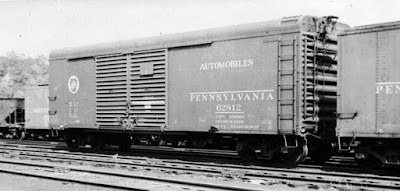Recently I posted a description of the first steps in restoring an old brass automobile car, specifically a Pennsylvania X31c model imported by Nickel Plate Products (made by KMT in Japan). The model was severely tarnished and had lost its trucks over the years. It required removing as much tarnish as possible, priming it, and painting. The post about all those steps is here: https://modelingthesp.blogspot.com/2020/09/restoring-old-brass-automobile-car.html .
I had painted the car with a brownish shade of boxcar red, and upon comparing it to other Pennsy models I have built, I decided it was a little too brown to portray what the PRR called “freight car color.” I went ahead and resprayed the body with Tamiya red primer (“Oxide Red” Fine Surface Primer L, no. 87160). This has been recommended by Pennsy modelers, and indeed, to my eye, this was a distinctly better PRR color.
Now came lettering. The Speedwitch Media decal set, no. D122, not only includes enough lettering for multiple cars, but has an instruction sheet with an excellent selection of prototype photos, along with the prototype lettering diagram. And the layout of the items on the decal sheet was obviously done by a modeler, because lettering elements that go together on the car are not only grouped together on the decal sheet but are correctly spaced. One could hardly ask for more.
Originally, most cars of this type looked like the view below (photo from the Clark Bauer collection, location unknown). This is a car in automobile service, as we know from the white door stripes. (The word “automobiles” on the car side tells us nothing; that was the AAR description for box cars with double doors.)
But in later years these cars were replaced in automobile service. Here’s an example of what I’m aiming at for the present model, shown in a 1952 photo (Arnold Menke collection). This car no longer has any automobile racks installed, though it is likely it once did; note the tubes beneath the floor in which the tie-down chains for auto loading were stored. For more on the topics of car use and lettering, see my post about PRR wagon-top box cars (view it at: https://modelingthesp.blogspot.com/2020/11/pennsy-freight-cars-part-5-round-roof.html ).
For any particular car number a person might choose, PRR included in its ORER listing (Official Railway Equipment Register) the individual car numbers of each class, with or without auto loading racks. The car number I chose from Speedwitch set D122, PRR 60873, the same as the first prototype photo above, was a box car by 1953, that is, no longer in the automobile service for which it had been built. Here’s the model at this point, remaining on its “interim truck support blocks” for decaling.
The next step is to add Bowser trucks of the correct PRR type, 2D-F12, with a leaf-spring snubber substituting for one spring group (Bowser no. 1-40194). I also added Kadee coupler boxes, using replacement metric screws since the model’s original ones were gone. As usual, the size that fits is 1.7 x 5 mm, 0.35 pitch. I used to buy these from NorthWest Short Line, but they are readily available all over the internet.Finally, the model needs weathering, followed by addition of paint patches for reweigh and repack stencils, and route cards. I weathered the model with my usual acrylic-wash technique. For paint patches, I used my normal approach with rectangles of colored decal, and used reweigh data from the Speedwitch decals. A small paper rectangle represents a route card on the left-hand door.
The car is now ready to return to its owner, who I am sure will direct it immediately to auto parts service on his 1956 layout.
Tony Thompson





I recently did a different NKP PRR model and used a Boswer floor/underframe allowing for better underbody detailing
ReplyDeleteGood idea. The original brass NKP floor / underframe is extremely minimal. The owner of the car I worked said "just get it painted," so I did, not adding things like corner grab irons on the roof.
DeleteTony Thompson